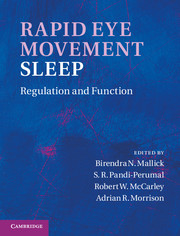Book contents
- Frontmatter
- Contents
- Contributors
- Preface
- Acknowledgments
- Organization
- Section I Historical context
- Section II General biology
- Section III Neuronal regulation
- Section IV Neuroanatomy and neurochemistry
- Section V Functional significance
- 30 Significance of deprivation studies
- 31 Modulation of body core temperature in NREM sleep and REM sleep
- 32 Sleep-related hippocampal activation: implications for spatial memory consolidation
- 33 The role of REM sleep in memory consolidation, enhancement, and integration
- 34 The role of REM sleep in emotional brain processing
- 35 REM-sleep loss, oxidative damage, and apoptosis
- 36 The role of REM sleep in maintaining neuronal excitability and its possible mechanism of action
- 37 Comparison of REM sleep-deprivation methods: role of stress and validity of use
- 38 REM sleep in patients with depression
- 39 Proteins and neuropeptides in REM-sleep regulation and function
- Section VI Disturbance in the REM sleep-generating mechanism
- Index
- Plate section
- References
38 - REM sleep in patients with depression
from Section V - Functional significance
Published online by Cambridge University Press: 07 September 2011
- Frontmatter
- Contents
- Contributors
- Preface
- Acknowledgments
- Organization
- Section I Historical context
- Section II General biology
- Section III Neuronal regulation
- Section IV Neuroanatomy and neurochemistry
- Section V Functional significance
- 30 Significance of deprivation studies
- 31 Modulation of body core temperature in NREM sleep and REM sleep
- 32 Sleep-related hippocampal activation: implications for spatial memory consolidation
- 33 The role of REM sleep in memory consolidation, enhancement, and integration
- 34 The role of REM sleep in emotional brain processing
- 35 REM-sleep loss, oxidative damage, and apoptosis
- 36 The role of REM sleep in maintaining neuronal excitability and its possible mechanism of action
- 37 Comparison of REM sleep-deprivation methods: role of stress and validity of use
- 38 REM sleep in patients with depression
- 39 Proteins and neuropeptides in REM-sleep regulation and function
- Section VI Disturbance in the REM sleep-generating mechanism
- Index
- Plate section
- References
Summary
Summary
Disinhibition of REM sleep is a characteristic finding in patients with major depression. REM disinhibition includes shortened REM latency, prolonged first REM periods, and increased REM density (measure of the frequency of rapid eye movements). REM latency, but not REM density, is influenced by age. REM-sleep changes appear to be closely related to the development and the course of depression. A relationship between REM-sleep changes before treatment and treatment outcome is suggested by several studies. REM density is elevated in healthy subjects who have a high genetic load for affective disorders. Most antidepressants suppress REM sleep in patients, normal controls, and laboratory animals. REM-sleep suppression appears to be a distinct hint for the antidepressive properties of a substance, whereas it is not absolutely required. REM-sleep variables during treatment with antidepressants appear to predict the course of the illness. The noradrenergic locus coeruleus and the serotonergic dorsal raphe nuclei, the cholinergic nuclei, and the nucleus of the solitary tract (NTS) are involved in sleep and mood regulation. Hyperaldosteronism has been demonstrated in major depression. Subchronic aldosterone administration can induce anxiety-like behavior. Because of the unusual presence within the brain of both mineralocorticoid receptors and 11-β hydroxysteroid dehydrogenase (11-β HSD), the NTS can act as the gate of the influence of peripheral aldosterone into the brain. Importantly, aldosterone secretion is closely related to the REM/non-REM cycle and is sensitive to sleep manipulations. Hypersecretion of corticotropin-releasing hormone (CRH), the key hormone of the hypothalamo–pituitary–adrenocortical system appears to participate in the pathophysiology of REM-sleep disinhibition. This is supported by increased time spent in REM sleep in mice overexpressing corticotropin-releasing hormone (CRH) in the brain. Furthermore CRH-receptor-type 1 antagonism seems to induce normalization of the REM-sleep changes related to the depression.
- Type
- Chapter
- Information
- Rapid Eye Movement SleepRegulation and Function, pp. 383 - 394Publisher: Cambridge University PressPrint publication year: 2011
References
- 1
- Cited by



